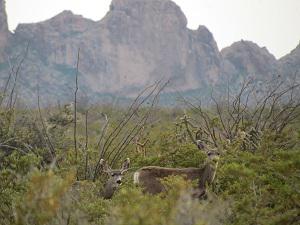Luz Adriana Perez Solano
The aim of this project is to identify the ecological strategies related to the movement and behaviour adopted by the mule deer in order to survive in a desert region in Mexico

Female mule deer and her fawn.
The mule deer (Odocoileus hemionus) has historically been one of the least studied species of deer in Mexico.
Populations of this cervid are naturally low in Mexico and have been decreasing from south to north and from east to west; these populations appear to be geographically isolated in various states in the north of Mexico, mainly as a result of the expansion in livestock production that has taken place in this region; which is the principal producer of bovine livestock in the country.
One of the most important sites across the distribution area of this species is the Mapimi Biosphere Reserve (MBR; located in the Chihuahua Desert, Mexico), since it represents the southernmost point at which populations of the species are found. The main objective of this research is to identify the ecological strategies related to the movement and behaviour adopted by the mule deer in order to survive in a desert region such as that of the MBR, and to determine how these are influenced by factors that are intrinsic (sex and physiological condition) and extrinsic (predation, seasonal changes, availability of and competition for resources) to the species.
This study is the first to be conducted in the MBR using the direct method of radiotelemetry. This method, together with the integration of spatial level analysis through geographic information systems, will allow us to acquire a broader view of the behaviour, movements and general habitat use of this species in desert regions, which will enable us to determine whether these deer are associated with certain landscape characteristics seasonally or throughout the entire year and whether the other habitats of the region could be acting as barriers to the dispersion of the species.
The study of habitat use, behavioural selection patterns and movement in this deer species are important in terms of identifying areas and resources that can influence the wellbeing of individuals as well as the viability of their populations, for which reason the results of this study will represent a valuable contribution to the knowledge of this species. Such knowledge is crucial to the creation of improved management and conservation plans at national level, as well as at the level of the Mapimi Reserve, the management protocol of which is still under development.